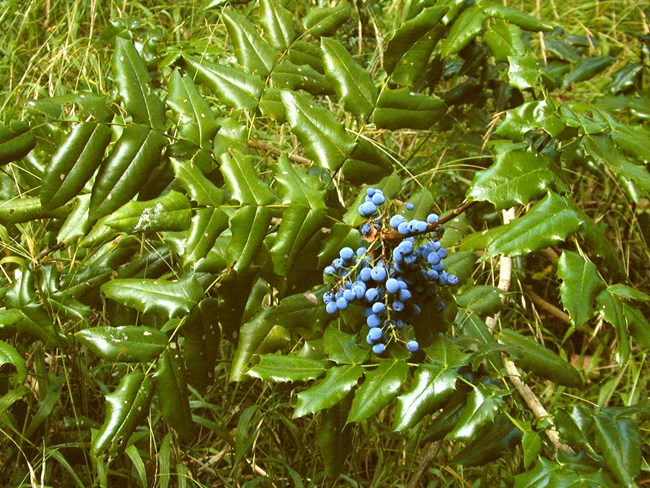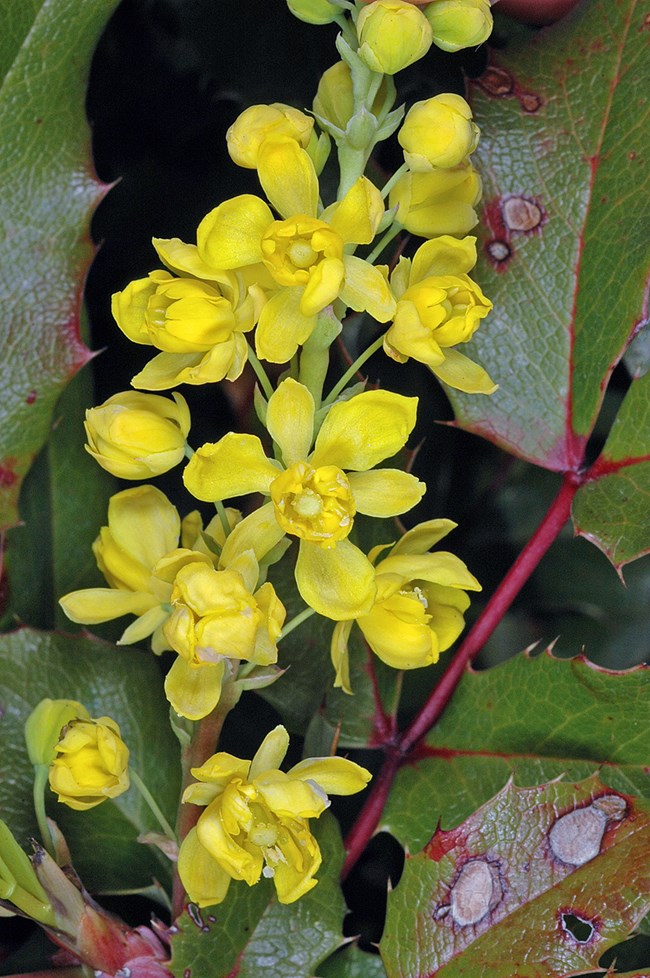Last updated: May 15, 2025
Article
Oregon Grape

DIG7412/©Bruce Newhouse/OregonFlora
General Description
Oregon grape, with its holly-like leaves, splashes a little year-round holiday cheer in forests and woods of the West. Several members of the barberry family, Berberidaceae, actually go by the common name of Oregon grape, with many variations, such as Oregon hollygrape, tall Oregon grape, hollyleaved barberry, and creeping barberry. The Berberis genus also goes by Mahonia, depending on taxonomy.
Unrelated to true grapes in the family Vitaceae, Oregon grape is an evergreen shrub, typically growing in the forest understory. In California and the Pacific Northwest, one of the most common species—and Oregon’s state flower—is Berberis aquifolium (also called tall Oregon grape, or hollyleaved barberry).
Tall Oregon grape typically grows 1–2 m (3–6 ft) tall and up to 1.5 m (5 ft) wide. Each compound “leaf” is actually a series of leaflets that grow in pairs on opposite sides of the leafstalk, except for the leading (terminal) leaf. Botanists call this configuration pinnate, from the Latin word pinnatus, meaning feathered. Sword ferns have pinnate leaves, as well as trees like the Oregon ash, walnut, and black locust, for example. The entire Oregon grape leaf can be up to 25 cm long (10 in). The oval- to oblong-shaped leaflets are shiny on top, with wavy spine-tipped edges. New leaves emerge with a bronze color before they turn bright green. In the fall, the leaves can take on red and burgundy hues, adding to the plant’s overall ornamental color palette through the course of a season.
Tall Oregon grape bears a cluster of bright yellow flowers in the spring, which are lightly scented. The flowers ripen into round, dusty blue-black berries, resembling grapes, by early fall. The berries are edible and seedy, though sour.

dig9084/©Gerald Carr/OregonFlora
Habitat and Distribution
Tall Oregon grape is shade tolerant and typically found in shrublands, rocky woods and coniferous forests in the Pacific Northwest and northern California. It is drought tolerant and can be found in relatively sunny areas as well.
Ecology and Reproduction
Tall Oregon grape feeds and shelters wildlife. Its berries nourish grouse, pheasants, robins, sparrows, and other fruit eaters (frugivores), including foxes and raccoons. Painted lady butterflies, mason bees, and other invertebrates drink its flower nectar. Small animals find cover in its densely clustered leaves.
Tall Oregon grape spreads by its belowground root system (rhizomes), though it can also regenerate by seed.
Ethnobotany
Various Oregon grape species are medicinally important. Native American tribes of the Pacific Northwest have used preparations from Oregon grape roots to treat stomach problems, hemorrhages, arthritis, and tuberculosis. Berberis species have long been used in Traditional Chinese Medicine to treat a variety of problems, including tuberculosis, dysentery, eczema, and wounds. Western medicinal uses for berberine, a compound derived from Berberis, include blood sugar stabilization, and studies show that it kills amoebae and can be used to treat giardia infections.
Boiling the roots and inner bark of Oregon grape produces a yellow dye used on wool. The Nlaka’pamux People of British Columbia applied it to their basketry.
Where to See
All Klamath Network parks except Lava Beds National Monument and Lassen Volcanic National Park contain at least one common species of Oregon grape (B. aquifolium, B. repens, or B. nervosa). Berberis aquifolium is specifically found in Crater Lake National Park, Redwood National and State Parks, and Oregon Caves National Monument and Preserve.
More Information
https://oregonencyclopedia.org/articles/oregon_grape/#.XA_5RnRKi70
http://www.metrofieldguide.com/wildlife-plants-oregon-grape/#
Download a pdf of this article.
Prepared by Sonya Daw
NPS Klamath Inventory & Monitoring Network
Southern Oregon University
1250 Siskiyou Blvd
Ashland, OR 97520
Featured Creature Edition: December 2018
